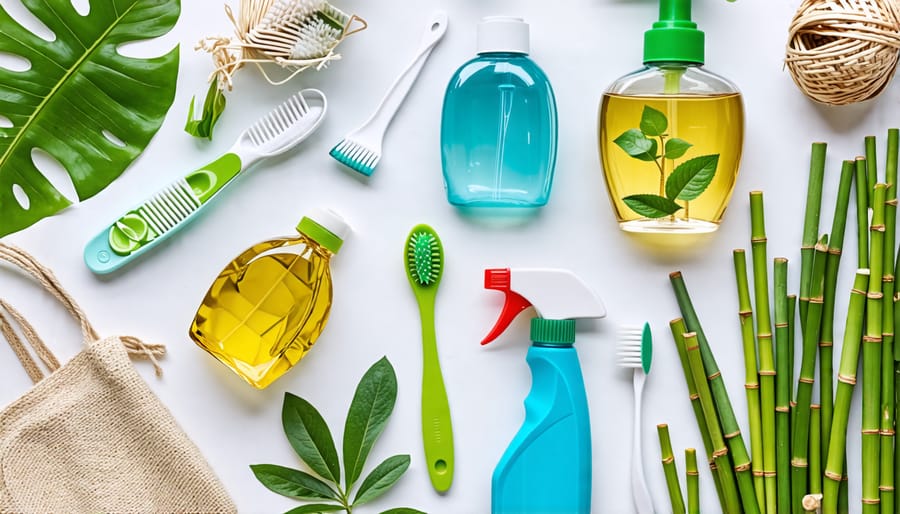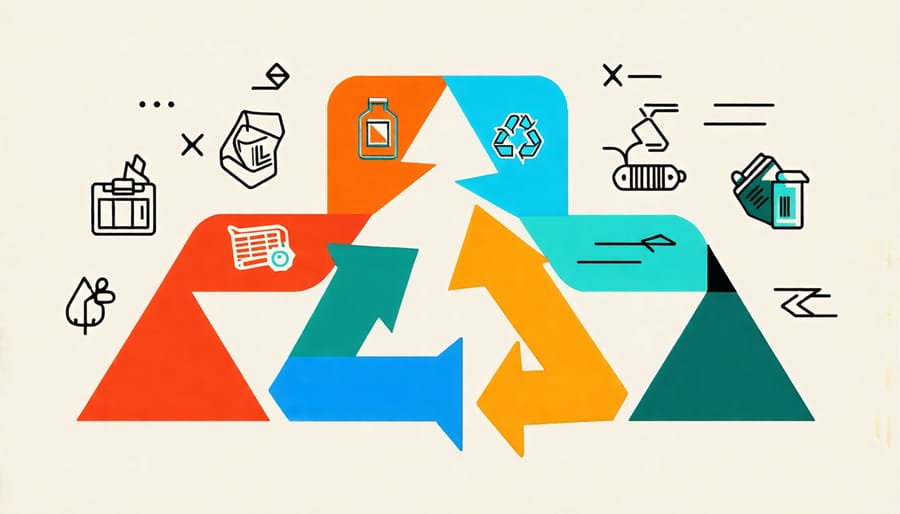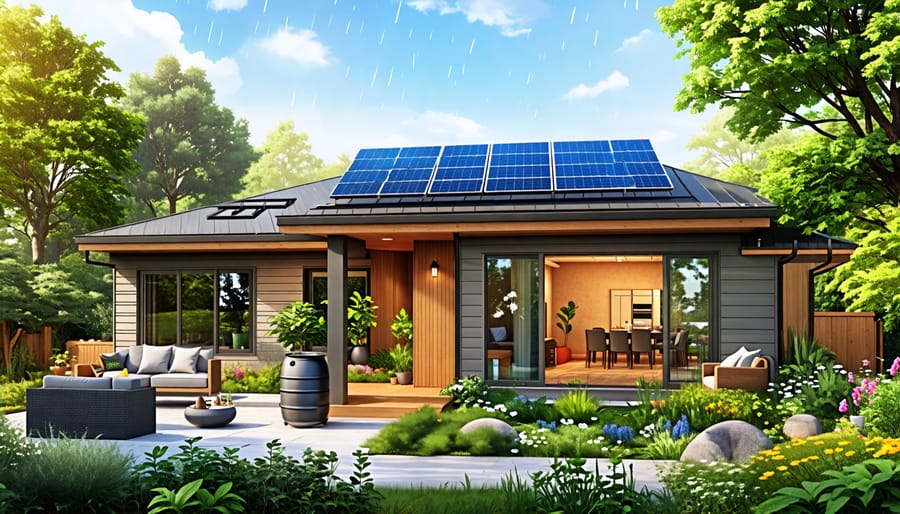Switch to energy-efficient LED bulbs to reduce electricity consumption. Install low-flow showerheads and faucet aerators to conserve water without sacrificing performance. Choose eco-friendly cleaning products made from natural, non-toxic ingredients to minimize harmful chemicals in your home. Make your house greener by composting food scraps and yard waste to create nutrient-rich soil for your garden while diverting organic matter from landfills.
Energy-Saving Strategies
Efficient Lighting
LED bulbs are an energy-efficient lighting solution that can significantly reduce your home’s carbon footprint. Compared to traditional incandescent bulbs, LEDs use up to 90% less energy and last 25 times longer. This means fewer bulbs end up in landfills and you save money on your electricity bill. When shopping for LEDs, look for the ENERGY STAR label to ensure quality and performance.
In addition to using efficient bulbs, maximize natural light in your home. Open curtains and blinds during the day to let sunlight in, reducing the need for artificial lighting. Consider installing skylights or solar tubes to bring natural light into darker areas of your home. When artificial light is necessary, use task lighting to focus illumination where it’s needed most, rather than relying on overhead lights. These simple changes can make a big difference in your energy consumption and contribute to a greener lifestyle.

Appliance Management
Choosing energy-efficient appliances is a key step in eco-friendly living. Look for the Energy Star label when shopping for new appliances, as these models use 10-50% less energy than standard options. To further reduce energy consumption, unplug devices when not in use or plug them into power strips that can be easily switched off. Many electronics continue to draw power even when turned off, so unplugging them eliminates this “phantom” energy drain. Power strips make it convenient to cut power to multiple devices at once, such as your entertainment system or home office setup. By being mindful of appliance efficiency and taking simple steps to reduce standby power consumption, you can significantly lower your home’s energy usage and environmental impact.
Water Conservation
Water conservation is essential for eco-friendly living, and there are many simple steps you can take to reduce your water usage at home. One of the most important things is to fix any leaks promptly, as even a small drip can waste gallons of water over time. Regularly check your faucets, showerheads, and toilets for leaks, and replace worn washers or seals as needed.
In the bathroom, consider taking shorter showers and turning off the water while you brush your teeth or shave. Installing low-flow showerheads and faucet aerators can also significantly reduce water consumption without sacrificing water pressure. When it’s time to replace your toilet, opt for a dual-flush or low-flow model to save even more water.
In the kitchen, avoid running the dishwasher until it’s fully loaded, and choose the eco-friendly cycle if available. When washing dishes by hand, fill the sink with soapy water instead of letting the tap run continuously. You can also save water by defrosting food in the refrigerator overnight rather than using running water.
Outdoors, water your lawn and garden early in the morning or late in the evening to minimize evaporation, and adjust your sprinklers to avoid watering sidewalks or driveways. Collecting rainwater in a barrel is an eco-friendly way to water your plants, and mulching your garden beds can help retain moisture and reduce the need for frequent watering. By implementing these simple water conservation tips, you can significantly reduce your environmental impact and save money on your utility bills.

Eco-Friendly Products
In the Kitchen
The kitchen is a great place to start when aiming to make your home more eco-friendly. One simple switch is to replace disposable paper napkins with reusable cloth ones, which can be washed and used repeatedly. When it comes to food storage, opt for glass or stainless steel containers instead of single-use plastic bags and wraps. These durable alternatives are not only better for the environment but also help keep your food fresh longer.
Another eco-friendly kitchen practice is composting food waste. By collecting fruit and vegetable scraps, coffee grounds, and eggshells in a compost bin, you can reduce the amount of waste sent to landfills while creating nutrient-rich soil for your garden. Consider incorporating biophilic design elements into your kitchen, such as indoor herb gardens or living walls, to further connect with nature and improve air quality.
When shopping for kitchen appliances, look for energy-efficient models with Energy Star ratings. These appliances use less energy and water, helping to reduce your carbon footprint and lower utility bills. Finally, be mindful of your water usage by fixing leaky faucets, using a dishwasher instead of hand-washing (when full), and installing low-flow aerators on your faucets.
Personal Care
When it comes to personal care, there are plenty of eco-friendly alternatives to traditional plastic products. Bamboo toothbrushes, for instance, are a great sustainable option. Not only are they biodegradable, but they’re also just as effective at cleaning your teeth. For your hair, consider switching to plastic-free shampoo and conditioner bars. These solid bars eliminate the need for plastic bottles and often last longer than their liquid counterparts. When it comes to skincare, look for products with natural, organic ingredients and minimal packaging. Reusable facial rounds made from organic cotton or bamboo can replace disposable cotton pads. And instead of single-use makeup wipes, opt for a washable, reusable cloth. By making these simple swaps in your personal care routine, you can significantly reduce your plastic waste and contribute to a greener lifestyle. Remember, every small change adds up to a big impact on the environment.
Reduce, Reuse, Recycle
Reducing, reusing, and recycling are the cornerstone principles of eco-friendly living. By minimizing waste and making the most of our resources, we can significantly reduce our environmental impact. Start by being mindful of your consumption habits – choose products with minimal packaging and avoid single-use items. Opt for reusable shopping bags, water bottles, and food containers. When something breaks, try to repair it before replacing it. Give new life to old items by repurposing them – turn glass jars into storage containers, convert old t-shirts into cleaning rags, or use empty cans as planters.
When it comes to recycling, familiarize yourself with your local guidelines. Most communities accept paper, cardboard, glass, and certain plastics. Set up separate bins for each category to make sorting easier. Remember that items should be clean and dry before recycling. There are also many items you should never throw away, such as electronics, batteries, and hazardous waste. These require special disposal methods to prevent environmental contamination. By being proactive in reducing, reusing, and recycling, you’ll not only minimize your waste but also conserve natural resources and support a more sustainable future. Small changes in your daily habits can add up to a significant positive impact on the planet.

Conclusion
In conclusion, adopting eco-friendly habits is a crucial step towards protecting our planet for future generations. By making simple changes like conserving energy and water, choosing sustainable products, and reducing waste, we can collectively make a significant impact. Remember, every small action counts – whether it’s turning off lights, fixing leaky faucets, or bringing reusable bags to the grocery store. As you incorporate these tips into your daily routine, you’ll not only be helping the environment but also saving money and improving your overall quality of life. So, start today and encourage others to join you in this important mission. Together, we can create a greener, healthier world for all. Let’s embrace eco-friendly living not as a temporary trend, but as a lifelong commitment to sustainability. By continuously learning, sharing ideas, and supporting each other, we can build a powerful movement of environmentally conscious individuals who are dedicated to making a difference.





